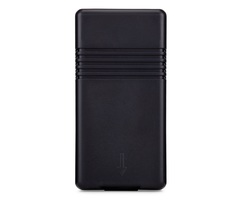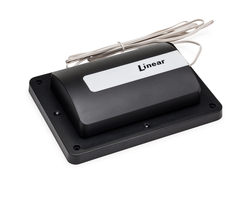Can an Alarm Sensor be Attached to a Garage Door?
Yes, an alarm sensor can be attached to a garage door. These are known as garage door alarm sensors. These devices will let the alarm system know if the garage door has been left open. A garage door alarm sensor is needed if you want to use a Z-Wave garage door controller with your system.

A garage door alarm sensor will tell a system if a garage door is still open. Whenever the garage door is open, a fault condition for the associated zone will be displayed on the panel. The user will need to restore the fault or bypass the sensor if they want to arm their system. Most garage door alarm sensor zones use a Response Type of "Garage". If the garage door alarm sensor is activated while the system is Armed, the user will need to Disarm the system within a set Entry Delay Period. Failure to Disarm before the Entry Delay period expires will result in an alarm.
Garage door alarm sensors come in two (2) main varieties. These are tilt sensors and contact sensors. Tilt sensors detect whether or not the garage door is open based on positioning. When the garage door is closed, the sensor will remain in a vertical position. Opening the garage door will move the sensor to a horizontal position. The sensor will recognize this change in position and alert the system when it is tilted. The system will then respond based on the set Response Type for the associated zone. An example of a garage door tilt sensor is the Honeywell 5822T.
Contact sensors represent the other main type of garage door alarm sensors. These devices consist of a main sensor and a smaller magnet. The sensor is normally installed on the garage door frame, while the magnet is installed on the moving portion of the garage door. For best results, the sensor and magnet should be in direct contact or in very close proximity when the garage door is closed. When the garage door is opened, the magnet will become separated from the sensor. This will release a metal reed switch inside the sensor. The sensor will recognize this and alert the system. The system will respond according to the Response Type for the zone.
Most garage door contacts have a larger magnet gap spacing rating than standard door and window contacts. This means that the sensor and magnet can be slightly further apart from each other before a zone fault will occur. We do not recommend using standard door and window contacts with garage doors. Doing so may result in false alarms. An example of a garage door contact with a large magnet spacing gap is the Honeywell 5816OD.
Please note that you will need a garage door alarm sensor if you intend on using a Z-Wave garage door controller with your security system. This is so that the system can know whether the garage door is currently opened or closed. The Z-Wave garage door controller will not be able to determine this on its own. It needs the sensor to let it know the current status. Some Z-Wave garage door controllers like the Linear GD00Z come with a garage door sensor for this purpose. Others like the Honeywell 5877 need to have one added separately. Alarm Grid sells a kit called the Honeywell GDCK that includes both the Honeywell 5877 and the Honeywell 5822T.
Did you find this answer useful?
We offer alarm monitoring as low as $10 / month
Click Here to Learn MoreRelated Products


Related Categories
- Answered


